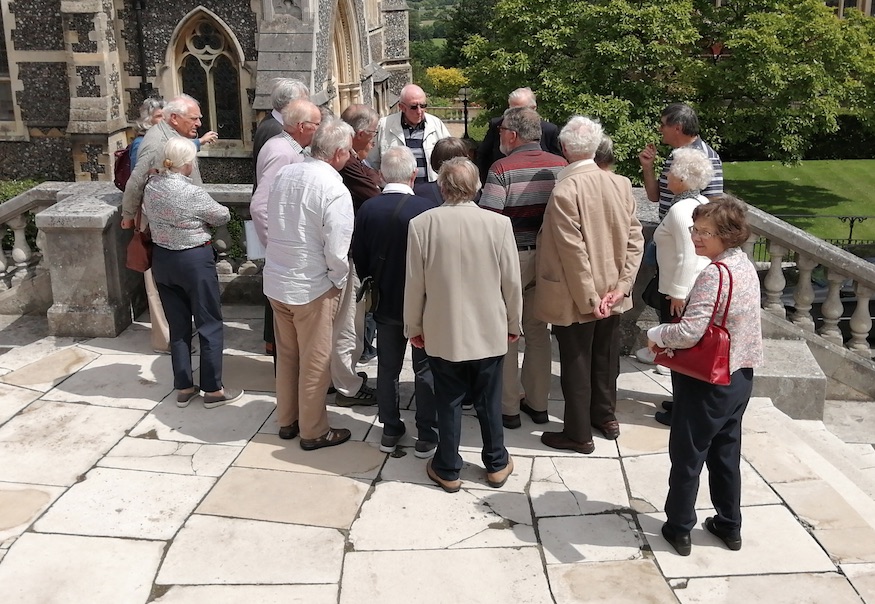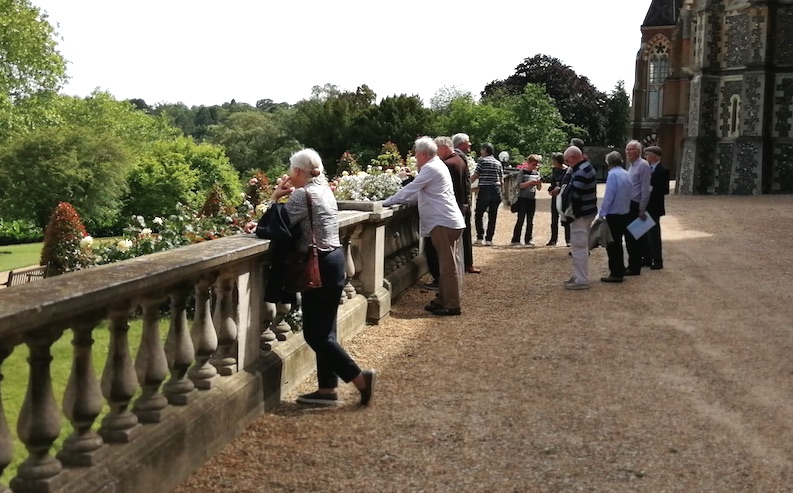Visit to Harrow School
Our member, Alan Carver, organised a most enjoyable guided tour of Harrow School. This gave us an opportunity to learn its history, explore the grounds and some of its historic buildings.
Twenty members of the Club, including one former pupil of Harrow School and their wives visited Harrow School.
The school was founded in 1572 under a Royal Charter from Queen Elizabeth I by a local landowner, John Lyon and the main original intention was to provide free “instruction in grammar” to local boys. The grammar related to Latin which was important at that time because it was the international language of trade and of the Church. Originally it was a day school but because of the state of the roads, even travelling short distances in all weathers and in the dark was dangerous, it became a boarding school as it remains today. Over the years many famous people have received their education at the school including five(foreign) monarchs and seven Prime Ministers.
Our first stop on the tour was at the Fourth Form Room which is the oldest part of the school but probably not the original. Here lessons were carried out in an atmospheric wood panelled room on to which had been carved the names of many pupils – originally an expelling offence. Our attention was drawn to a number of famous names including Byron, Churchill and Peel. The school we see today is not recognisable from the early days. Entry is still for boys only, all of which are boarders but it is no longer free. There are about 830 pupils with an average class size of fourteen, who live in twelve (mainly Victorian) boarding houses, with 150 teachers and a total staff of around 700.
The school is located on a hill so our tour involved much hill and stair climbing during which we saw the vast sporting facilities available to pupils extending over 300 acres, including a running track, nine hole golf course, leisure centre as well as numerous tennis courts and football and cricket pitches. No less than 13 languages are taught in the Languages Block. On returning to the main complex we passed the Refectory where food is prepared on an industrial scale, serving 3,000 meals per day. Our final stop of the day was at the Speech Room – a huge Victorian hall, complete with organ and a stage, used for many purposes including assemblies for the whole school, concerts, drama and school singsongs. At this point our former pupil, Robin Barton, was invited to sing a school song to us – an invitation he declined and instead read to us one of their rousing songs. The school enjoys “charitable status” and in order to obtain and retain this it must show that itprovides “public benefit”. This it does in numerous ways, including opening its various sporting facilities to local residents and providing bursaries to pupils who could not normally afford the fees.
A further requirement is to provide independent secondary education which maximises a pupil’s potential and lifelong interests and we saw ample evidence to show that nothing is spared in order to achieve this particular aim. As a footnote it is worth recording that the historical importance of both the establishments visited is emphasised by the fact that they are used in films and for TV to provide an authentic and appropriate background for programmes.
------------------------------------
The morning was spent at Uxbridge, where we visited the Battle of Britain Bunker and Visitor Centre which featured state of the art audio visual interactive displays showing the development of UK’s air defence system from WW1 until the end of WW2. Also on display were actual examples of anti-aircraft guns, aircraft searchlights, and sirens in use during this time, as well as life size models of Hurricane and Spitfire aircrafts.
The story begins with attacks during WW1 by Zeppelin airships and how they were repelled and gradually unfolds with the aid of photographs and personal accounts of incidents, reaching its climax with the Battle of Britain.
By 1939 the air defence system was in three layers with an early warning system of radar towers at ten mile intervals along the south east coast of England which could spot enemy aircraft heading our way at a distance of about 100 miles. Secondly there were the Royal Observer Corps whose personnel were located throughout south east England who took over from the radar and continued to plot the course of the attackers after they had crossed the coast. This information was conveyed by landline telephone to the Bunker where it was assessed by controllers who decided which airfields were most appropriate for use in attacking the enemy aircraft, the intention always being to get the fighters (the third layer of the defence system) into the air as soon as possible so that they had the advantage of being able to attack the raiders from above.
The Bunker. This is a separate structure and on the way to it examples of the Spitfire and Hurricane aircraft are displayed. We were given a brief history of both by our guide and he surprised at least one of our group when he said that the Hurricane was chiefly responsible for our winning the Battle of Britain. His reasoning for this being that they were of a simpler design than the Spitfire and could therefore be constructed more quickly so there were more of them. They could also be repaired more quickly. The bunker was considered at the time of construction to be in a bomb proof location 60 feet underground and is reached by 76 steps. The control room is dominated by a large map of the south of England on which the position of the raiders is plotted from information received from the radar stations and the Observer Corps together with details of the aircraft deployed to meet the threat. Covering one wall is a display showing the state of readiness of the aircraft at the seven fighter stations controlled from the Bunker.
The Battle of Britain Bunker and Visitor Centre was well worth a visit. We were surprised at the level of sophistication and effectiveness that was achieved more than seventy years ago.

